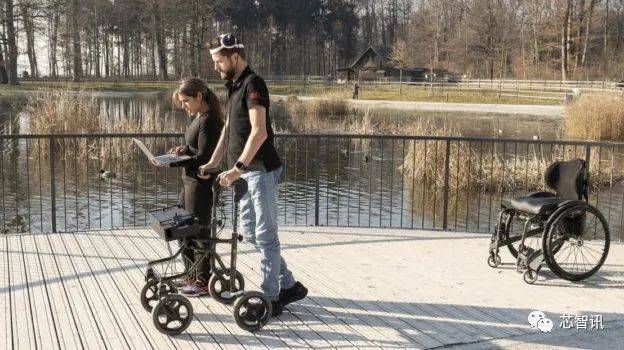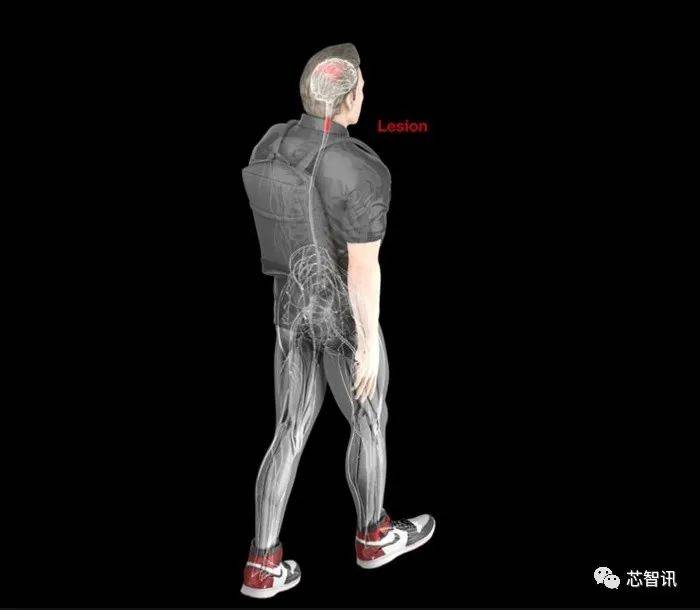Home >Technology peripherals >AI >A Dutch man who has been paralyzed for 10 years regains walking with a brain-computer interface implant!
A Dutch man who has been paralyzed for 10 years regains walking with a brain-computer interface implant!
- WBOYWBOYWBOYWBOYWBOYWBOYWBOYWBOYWBOYWBOYWBOYWBOYWBforward
- 2023-05-30 09:08:501144browse

News on May 26, according to the Swiss Federal Institute of Technology in Lausanne, a recent study published in the journal Nature showed that researchers successfully helped a man with paralysis of the lower body through implanted brain-computer interface technology. A man who has been recovering for more than 10 years has had his brain and spinal cord reconnected. Now he has regained the ability to walk smoothly, whether on uneven terrain or climbing stairs, relying on mind control.
It is reported that this progress is the result of more than ten years of joint efforts by Swiss and French researchers. The two implants (one in the brain, the other in the spinal cord) create a "digital bridge" that can reestablish the connection between the patient's brain and spinal cord.

▲ This new technology is to implant the brain-computer interface above the area of the brain that controls leg movements (the red area of the brain). After interpreting the patient’s thoughts through computers and AI algorithms, the control instructions are transmitted to the patient through a portable device. With the spinal cord implant (red area below), patients can walk under the control of their thoughts.
Neurosurgeon Jocelyne Bloch, professor at CHUV, UNIL and EPFL, explains: “We implanted WIMAGINE® devices over the areas of the brain responsible for controlling leg movements. These devices, developed by CEA, are able to decode electrical signals and Like the brain feels like we're walking. We installed a neurostimulator above the spinal cord area to easily connect to the electrode array and control the leg movements.
Grégoire Courtine, professor of neuroscience at EPFL, CHUV and UNIL, said, “We used brain-computer interface (BCI) technology to create a wireless interface between the patient’s brain and spinal cord that converts thoughts into actions, allowing the patient to connect directly to the spinal cord. You can still walk naturally after the injury."
Guillaume Charvet, head of the CEA BCI project, added: "Thanks to algorithms based on adaptive artificial intelligence methods, motor intentions can be decoded in real time from the brain recordings. Next, by converting these intentions into spinal cord electrical stimulation sequences, the stimulation leg muscles to achieve the desired movement. The digital bridge operates wirelessly, allowing patients to move independently.
Gert-Jan, 40, of the Netherlands, participated in the trial and said he was injured in a bicycle accident, causing spinal cord damage, which resulted in paralysis. Now, he can control the movement of his paralyzed leg, allowing him to stand, walk and even climb stairs. Gert-Jan explains that he has regained the pleasure of being able to stand at the bar and share a beer with friends: “This simple pleasure represents a major change in my life”.
Gert-Jan regained neurological function lost after the accident, thanks to rehabilitation treatments supported by a digital bridge. Even with the digital bridge turned off, the researchers were still able to quantitatively sense and improve his motor skills. This digital restoration of the spinal cord shows that new neural connections have been formed.
However, at this stage, the digital bridge has only been tested on one person. Jocelyne Bloch and Grégoire Courtine explain that similar strategies could be used in the future to restore arm and hand function. They noted that digital bridges could also be used for other clinical indications, such as paralysis due to stroke. ONWARD Medical, together with CEA and EPFL, has received support from the European Commission through its European Innovation Council (EIC) to develop a commercial version of the digital bridge, with the goal of making the technology available globally.
Editor: Xinzhixun-Rurounijian
Xin Zhixun’s previous related articles:
"The United States will ban "brain-computer interface" technology from China"
"[In-depth analysis] The current situation and future of brain-computer interface technology! 》
"Brain-computer interface technology: gradually moving from science fiction to reality"
"Musk uses live pigs to demonstrate new brain-computer interface technology: pig brain information can be read in real time"
"Academician Luo Qingming: China has led the world in the field of "brain structure mapping and imaging"! 》
The above is the detailed content of A Dutch man who has been paralyzed for 10 years regains walking with a brain-computer interface implant!. For more information, please follow other related articles on the PHP Chinese website!
Related articles
See more- Technology trends to watch in 2023
- How Artificial Intelligence is Bringing New Everyday Work to Data Center Teams
- Can artificial intelligence or automation solve the problem of low energy efficiency in buildings?
- OpenAI co-founder interviewed by Huang Renxun: GPT-4's reasoning capabilities have not yet reached expectations
- Microsoft's Bing surpasses Google in search traffic thanks to OpenAI technology

